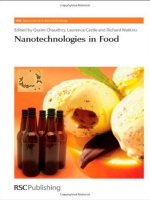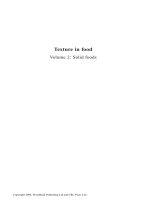Texture in food volume 2
Bạn đang xem bản rút gọn của tài liệu. Xem và tải ngay bản đầy đủ của tài liệu tại đây (6.17 MB, 539 trang )
Texture in food
Volume 2: Solid foods
Copyright 2004, Woodhead Publishing Ltd and CRC Press LLC
Related titles from Woodhead’s food science, technology and
nutrition list:
Texture in food Volume 1: Semi-solid foods (ISBN 1 85573 673 X)
Understanding and controlling the texture of semi-solid foods such as yoghurt and ice
cream is a complex process. With a distinguished international team of contributors,
this important collection summarises some of the most significant research in this
area. The first part of the book looks at the behaviour of gels and emulsions, how they
can be measured and their textural properties improved. The second part of the
collection discusses the control of texture in particular foods such as yoghurt, ice
cream, spreads and sauces.
Understanding and measuring the shelf-life of food (ISBN 1 85573 732 9)
The shelf-life of a product is critical in determining both its quality and profitability.
This important collection reviews the key factors in determining shelf-life and how
they can be measured.
Taints and off-flavours in foods (ISBN 1 85573 449 4)
Taints and off-flavours are a major problem for the food industry. The first part of
this important collection reviews the major causes of taints and off-flavours, from
oxidative rancidity and microbiologically-derived off-flavours, to packaging materials
as a source of taints. The second part of the book discusses the range of techniques for
detecting taints and off-flavours, from sensory analysis to instrumental techniques,
including the development of new rapid, on-line sensors.
Details of these books and a complete list of Woodhead’s food science, technology
and nutrition titles can be obtained by:
••
••
• visiting our web site at www.woodhead-publishing.com
••
••
• contacting Customer services (e-mail: ;
fax: +44 (0) 1223 893694; tel.: +44 (0) 1223 891358 ext.30; address: Woodhead
Publishing Ltd, Abington Hall, Abington, Cambridge CB1 6AH, England)
Selected food science and technology titles are also available in electronic form. Visit
our web site (www.woodhead-publishing.com) to find out more.
If you would like to receive information on forthcoming titles in this area, please send
your address details to: Francis Dodds (address, tel. and fax as above; e-mail:
). Please confirm which subject areas you are
interested in.
Copyright 2004, Woodhead Publishing Ltd and CRC Press LLC
Texture in food
Volume 2: Solid foods
Edited by
David Kilcast
CRC Press
Boca Raton Boston New York Washington, DC
W OODHEAD PUBLISHING LIMITED
Cambridge England
Copyright 2004, Woodhead Publishing Ltd and CRC Press LLC
Published by Woodhead Publishing Limited, Abington Hall, Abington
Cambridge CB1 6AH, England
www.woodhead-publishing.com
Published in North America by CRC Press LLC, 2000 Corporate Blvd, NW
Boca Raton FL 33431, USA
First published 2004, Woodhead Publishing Ltd and CRC Press LLC
© 2004, Woodhead Publishing Ltd
The authors have asserted their moral rights.
This book contains information obtained from authentic and highly regarded sources.
Reprinted material is quoted with permission, and sources are indicated. Reasonable
efforts have been made to publish reliable data and information, but the authors and
the publishers cannot assume responsibility for the validity of all materials. Neither
the authors nor the publishers, nor anyone else associated with this publication, shall
be liable for any loss, damage or liability directly or indirectly caused or alleged to be
caused by this book.
Neither this book nor any part may be reproduced or transmitted in any form or
by any means, electronic or mechanical, including photocopying, microfilming and
recording, or by any information storage or retrieval system, without permission in
writing from the publishers.
The consent of Woodhead Publishing and CRC Press does not extend to copying
for general distribution, for promotion, for creating new works, or for resale. Specific
permission must be obtained in writing from Woodhead Publishing or CRC Press for
such copying.
Trademark notice: Product or corporate names may be trademarks or registered trademarks,
and are used only for identification and explanation, without intent to infringe.
British Library Cataloguing in Publication Data
A catalogue record for this book is available from the British Library.
Library of Congress Cataloging in Publication Data
A catalog record for this book is available from the Library of Congress.
Woodhead Publishing ISBN 1 85573 724 8 (book) 1 85573 836 8 (e-book)
CRC Press ISBN 0-8493-2537-4
CRC Press order number: WP2537
The publisher’s policy is to use permanent paper from mills that operate a sustainable
forestry policy, and which have been manufactured from pulp which is processed using
acid-free and elementary chlorine-free practices. Furthermore, the publisher ensures that
the text paper and cover board used have met acceptable environmental accreditation
standards.
Typeset by Replika Press Pvt Ltd, India.
Printed by TJ International Ltd, Padstow, Cornwall, England.
Copyright 2004, Woodhead Publishing Ltd and CRC Press LLC
Contents
Contributor contact details
List of abbreviations
Part I Consumers, texture and food quality
1 Measuring consumer perceptions of texture: an
overview
D. Kilcast, Leatherhead Food International, UK
1.1 Introduction: texture and food quality
1.2 Perception and sensory assessment of food
texture
1.3 Tests and test procedures
1.4 Instrumental measurement of texture
1.5 In vivo texture measurement
1.6 Future developments
1.7 Conclusions
1.8 References
2 Consumers and texture: understanding their perceptions
and preferences
J-F. Meullenet, University of Arkansas, USA
2.1 Introduction: problems with consumer descriptions of
texture
2.2 Investigating consumer descriptions of texture
2.3 Tests and test procedures
2.4 Understanding consumer preferences
2.5 Challenges to understanding consumer
preferences
2.6 Future trends
2.7 Conclusions
2.8 References
Copyright 2004, Woodhead Publishing Ltd and CRC Press LLC
3 Texture and mastication
A. C. Smith, Institute of Food Research, UK
3.1 Introduction
3.2 The mastication process
3.3 Measuring mastication
3.4 Chewing, swallowing, salivation and bolus formation
3.5 Future trends
3.6 Mastication and particular foods
3.7 Reviews
3.8 Acknowledgement
3.9 References
4 Understanding and measuring consumer perceptions
of crispness
P. Mallikarjunan, Virginia Polytechnic Institute and
State University, USA
4.1 Introduction
4.2 Characterization and determination of crispness
4.3 Methods of data correlation, evaluation and analysis
4.4 Case-study: breaded chicken nuggets
4.5 Future trends
4.6 References
Part II Instrumental techniques for analysing texture
5 Force/deformation techniques for measuring texture
R. Lu and J. A. Abbott, USDA Agricultural Research
Service, USA
5.1 Introduction
5.2 Mechanical characterization of solid foods
5.3 Destructive measurements
5.4 Non-destructive measurements
5.5 Conclusions
5.6 References
6 Sound input techniques for measuring texture
L. M. Duizer, Massey University, New Zealand
6.1 Introduction
6.2 Sound and its detection: what is sound?
6.3 Destructive testing
6.4 Non-destructive testing
6.5 Application of sound measurement techniques
6.6 Future trends
6.7 Sources of further information and advice
6.8 References
Copyright 2004, Woodhead Publishing Ltd and CRC Press LLC
7 Near infrared (NIR) diffuse reflectance in texture
measurement
S. Millar, Campden and Chorleywood Food Research
Association, UK
7.1 Introduction
7.2 Application of NIR to cereals and their products
7.3 Application of NIR to fruit and vegetables
7.4 Application of NIR to meat
7.5 Application of NIR to other foods
7.6 Conclusions and future trends
7.7 Sources of further information
7.8 References
8 Nuclear magnetic resonance (NMR) and magnetic
resonance imaging (MRI) in texture measurement
A. K. Thybo, A. H. Karlsson, H. C. Bertram and
H. J. Andersen, Danish Institute of Agricultural Sciences,
P. M. Szczypinski, Technical University of Lodz, Poland
and S. Donstrup, Aarhus University Hospital, Denmark
8.1 Introduction
8.2 Methods and analysis
8.3 Application of NMR: texture determination of solid
foods
8.4 Application of MRI: texture determination of solid
foods
8.5 Future trends
8.6 References
9 Modelling food texture
L. M. M. Tijskens and H. Luyten, Wageningen University
and Research Centre, The Netherlands
9.1 Introduction
9.2 Factors affecting texture
9.3 Effects of enzymes on texture
9.4 Applying models to predict texture
9.5 Future trends
9.6 Notation
9.7 References
Part III Understanding and improving the texture of
particular foods
10 Plant structure and fruit and vegetable texture
K. W. Waldron, Institute of Food Research, UK
10.1 Introduction
Copyright 2004, Woodhead Publishing Ltd and CRC Press LLC
10.2 Measurement of texture
10.3 Plant structure
10.4 Cellular basis of crispness, juiciness and mealiness in
fruit tissue
10.5 Cellular stability during processing
10.6 Improving cell adhesion
10.7 Future trends
10.8 Acknowledgements
10.9 References
11 Plant compounds and fruit texture: the case of pear
T. Kojima, S. Fujita and M. Tanaka, Saga University,
Japan and P. Sirisomboon, King Mongkut’s Institute
of Technology Ladkrabang, Thailand
11.1 Introduction: variations in pear texture
11.2 Measuring and modelling fruit firmness
11.3 Chemical compounds affecting firmness: the example
of Japanese pear
11.4 The effect of constituents on fruit
texture
11.5 Use of near infrared spectroscopy (NIR) to evaluate
textural properties
11.6 Future trends
11.7 Sources of further information and advice
11.8 Acknowledgement
11.9 References
12 Controlling the texture of fruit and vegetables: the role
of oxidising enzymes
H. J. Wichers and C. Boeriu, Agrotechnology and Food
Innovations, The Netherlands
12.1 Introduction: distribution of polyphenoloxidases
(PPOs) and peroxidases (PODs) in plants and
plant cells
12.2 Biochemical and physiological role of PPOs and
PODs
12.3 PPOs and PODs: structure and mechanisms of
action
12.4 PPOs, PODs and texture development
12.5 Controlling PPO and POD activity
12.6 PPOs and PODs: implications for food texture
12.7 Future trends
12.8 Sources of further information
12.9 References
Copyright 2004, Woodhead Publishing Ltd and CRC Press LLC
13 Improving fruit and vegetable texture by genetic
transformation
G. Tucker, University of Nottingham, UK
13.1 Introduction
13.2 Tools of genetic modification
13.3 Approaches to the manipulation of texture: the
tomato
13.4 Other approaches to the manipulation of texture
13.5 Future trends
13.6 References
14 Raw materials quality and the texture of processed
vegetables
J. B. Adams, formerly of CCFRA, UK
14.1 Introduction
14.2 Vegetable texture determined by starch
14.3 Vegetable texture determined by cell wall
polysaccharides
14.4 Vegetable texture affected by phenolic reactions
14.5 Future trends
14.6 Sources of further information and advice
14.7 References
15 Improving the texture of processed vegetables by
vacuum infusion
R. Saurel, University of Lyon, France
15.1 Introduction
15.2 Vacuum infusion technology
15.3 Applications to improve texture
15.4 Future trends
15.5 Sources of further information and advice
15.6 References
16 Improving the texture of frozen fruit: the case of
berries
M. Suutarinen and K. Autio, VTT Biotechnology, Finland
16.1 Introduction: the effects of freezing and thawing
on berry texture
16.2 Maintaining texture: conventional pre-freezing
treatments
16.3 Maintaining texture: alternative pre-freezing
treatments
16.4 Application: frozen berries and jams
16.5 Future trends
16.6 References
Copyright 2004, Woodhead Publishing Ltd and CRC Press LLC
17 Improving the texture of processed fruit: the case
of olives
I. Mafra, University of Porto and M. A. Coimbra, University
of Aveiro, Portugal
17.1 Introduction: the texture of table olives
17.2 Factors affecting the texture quality of raw olives
17.3 Influence of processing on table olives
17.4 Improving texture
17.5 Future trends
17.6 Sources of further information and advice
17.7 References
18 Improving the texture of bread
S. P. Cauvain, CCFRA, UK
18.1 Introduction
18.2 Textural characteristics of bread and other
cereal-based foods
18.3 Definitions of texture
18.4 Measuring texture
18.5 Influence of processing and storage
18.6 Improving texture
18.7 Future trends
18.8 Sources of further information and advice
18.9 References
19 Analysing and improving the texture of cooked rice
S. K. Kim, Dankook University and C. O. Rhee,
Chonnam National University, Korea
19.1 Introduction
19.2 Criteria for evaluating rice quality
19.3 Hydration of rice
19.4 Factors affecting cooking quality
19.5 Testing texture quality
19.6 Problems and challenges
19.7 Sources of further information and advice
19.8 References
20 Improving the texture of pasta
B. A. Marchylo and J. E. Dexter, Canadian Grain Commission
and L. J. Malcolmson, Canadian International Grains Institute
20.1 Introduction
20.2 Measuring the texture of cooked pasta
20.3 Influence of raw materials
20.4 Influence of processing
20.5 Trends in consumer preference
20.6 References
Copyright 2004, Woodhead Publishing Ltd and CRC Press LLC
21 Improving the texture of fried food
C-J. Shieh and C-Y. Chang, Da-Yeh University and
C-S. Chen, Chao-Yang University of Technology, Taiwan
21.1 Introduction
21.2 Measuring texture
21.3 Factors influencing texture
21.4 The use of response surface methodology (RSM)
21.5 A case study: fried gluten balls
21.6 Conclusions
21.7 References
Copyright 2004, Woodhead Publishing Ltd and CRC Press LLC
Contributor contact details
(* = main point of contact)
Chapter 1
Dr D. Kilcast
Leatherhead Food International
Randalls Road
Leatherhead
Surrey
KT22 7RY
UK
Tel: +44 (0) 1372 822321
Fax: +44 (0) 1372 386228
E-mail:
Chapter 2
Professor J-F. Meullenet
Department of Food Science
University of Arkansas
2650 N. Young Avenue
Fayetteville, AR
72704
USA
Tel: +1 (479) 236 1926
Fax: +1 (479) 575 6936
E-mail:
Chapter 3
Dr A. C. Smith
Food Quality & Materials Science
Division
Institute of Food Research
Norwich Research Park, Colney
Norwich
NR4 7UA
UK
Tel: +44 (0) 1603 255286
Fax: +44 (0) 1603 507723
E-mail:
Chapter 4
Dr P. Mallikarjunan
Biological Systems Engineering
Department
312 Seitz Hall
Virginia Polytechnic Institute and
State University
Blacksburg VA 24060
USA
Tel: +1 (540) 231 7937
Fax: +1 (540) 231 3199
E-mail:
Copyright 2004, Woodhead Publishing Ltd and CRC Press LLC
Chapter 5
Dr Renfu Lu*
USDA ARS Sugarbeet and Bean
Research Unit
224 Farrall Hall
Michigan State University
East Lansing, MI 48824
USA
Tel: +1 (517) 432-8062
Fax: +1 (517) 337-6782
E-mail:
Dr Judith A. Abbot
USDA ARS Produce Quality &
Safety Laboratory
Building 002, BARC-W
10300 Baltimore Avenue
Beltsville, MD 20705-2350
USA
Tel: +1 (301) 504 6128
Fax: +1 (301) 504 5107
E-mail:
Chapter 6
Dr L. M. Duizer
Institute of Food, Nutrition and
Human Health
Massey University
Private Bag 102 904 NSMC
Albany, Auckland
New Zealand
Tel: +64 09 443 9753
Fax: +64 09 443 9640
E-mail:
Chapter 7
Dr S. Millar
Baking and Cereals Processing
Department
Campden & Chorleywood Food
Research Association
Chipping Campden
Gloucestershire
GL55 6LD
UK
Tel: +44 (0) 1386 842157
Fax: +44 (0) 1386 842150
E-mail:
Chapter 8
Dr A. K. Thybo*
Department of Food Science
Danish Institute of Agricultural
Sciences
DK-5792 Aarslev
Denmark
Tel: +045 63 90 43 05
Fax: +045 63 90 43 95
E-mail:
Dr A. H. Karlsson, Dr H. C.
Bertram and Dr H. J. Andersen
Department of Food Science
Danish Institute of Agricultural
Sciences
DK-8830 Tjele
Denmark
Tel: +045 89 99 19 00
Fax: +045 89 99 15 64
E-mail:
Dr S. Donstrup
Aarhus University Hospital
Department of Biomedical
Engineering
DK-8200 Aarhus N
Denmark
Copyright 2004, Woodhead Publishing Ltd and CRC Press LLC
Dr P. M. Szczypinski
Institute of Electronics
Technical University of Lodz
90-924 Lodz
Poland
Tel: +48 42 636 2238
Fax: +48 42 631 2638
E-mail:
Chapter 9
L. M. M. Tijskens* and Dr H.
Luyten
Wageningen University and
Research Centre
Agrotechnology & Food
Innovations
PO Box 17
6700 AA Wageningen
The Netherlands
Tel: +31 317 475 303
Fax: +31 317 475 347
E-mail:
Chapter 10
Dr K. W. Waldron
Institute of Food Research
Norwich Research Park
Colney
Norwich
NR4 7UA
UK
Tel: +44 1603 255385
Fax: +44 1603 507723
E-mail:
Chapter 11
Dr T. Kojima, Dr S. Fujita and
Dr M. Tanaka
Saga University
Japan 840-8502
Tel: +81 952 288 750
Fax: +81 952 288 768
E-mail:
Dr P. Sirisomboon*
Department of Agricultural
Engineering
Faculty of Engineering
King Mongkut’s Institute of
Technology Ladkrabang
Bangkok 10520
Thailand
Tel: +66 2737 300 ext 5120
Fax: +66 2326 4178
E-mail:
Chapter 12
Dr H. J. Wichers and Dr C. Boeriu
Agrotechnology & Food Innovations
Bornsesteeg 59
6708 PD Wageningen
The Netherlands
Tel: +31 317 475228
Fax: +31 317 475347
E-mail:
Chapter 13
Professor G. Tucker
University of Nottingham
School of Biosciences
Copyright 2004, Woodhead Publishing Ltd and CRC Press LLC
Sutton Bonington Campus
Loughborough
Leicestershire
LE12 5RD
UK
Tel: +44 (0) 1159 516 126
Fax: +44 (0) 1159 516 122
E-mail:
Chapter 14
Dr J. B. Adams
5 Orchard View
Draycott
Moreton-in-Marsh
Gloucestershire
GL56 9LW
UK
Tel: +44 (01386) 700374
E-mail:
Chapter 15
Dr R. Saurel
University of Lyon
Rue Henri de Boissieu
01 060 Bourg-en-Bresse
Cedex 09
France
Tel: +33 (0)4 74 45 52 52
Fax: +33 (0)4 74 45 52 53
E-mail:
Chapter 16
Dr M. Suutarinen and Dr K. Autio*
VTT Biotechnology
PO Box 1500, 02044 VTT
Finland
Tel: +358 9 4565175
Fax: +358 9 4552103
E-mail:
Chapter 17
Professor M. A. Coimbra*
Department of Chemistry
University of Aveiro
PT 3810-193 Aveiro
Portugal
Tel: +1 351 234 370 706
Fax: +1 351 234 370 084
E-mail:
Dr I. Mafra
REQUIMTE
Laboratory of Bromatology
Faculty of Pharmacy
University of Porto
R Anibal Cunha, 164
PT 4050-047 Porto
Portugal
Tel: +351 22 2078902
Fax: +351 22 2003977
E-mail:
Chapter 18
Dr S. P. Cauvain
Campden & Chorleywood Food
Research Association
Chipping Campden
Gloucestershire
GL55 6LD
UK
Tel: +44 (0) 1386 842 000
Fax: +44 (0) 1386 842 150
E-mail:
Copyright 2004, Woodhead Publishing Ltd and CRC Press LLC
Chapter 19
Dr S. K. Kim*
Dankook University
Korea
Tel: +82 2 709 2426
Fax: +82 2 790 2447
E-mail:
Dr C. O. Rhee
Chonnam National University
Korea
Tel: +82 62 530 2142
Fax: +82 530 2149
E-mail:
Chapter 20
Dr B. A. Marchylo* and Dr
J. E. Dexter
Grain Research Laboratory
Canadian Grain Commission
1404-303 Main Street
Winnipeg MB R3C 3G8
Canada
Tel: +1 (204) 983 3320
Fax: +1 (204) 983 0724
E-mail:
Dr L. J. Malcolmson
Canadian International Grains
Institute
1000-303 Main Strect
Winnipeg MB R3C 3G7
Canada
Tel: +1 (204) 983 8584
Fax: +1 (204) 983 2642
E-mail:
Chapter 21
Dr C-J. Shieh and Dr C-Y. Chang
Department of Food Engineering
Da-Yeh University
Cheng-Hwa
Taiwan 515
E-mail:
Dr C-S. Chen*
Department of Applied Chemistry
Chao-Yang University
of Technology
168 Gifeng E. Rd, Wufeng
Taichung County
Taiwan
Fax: +886 4 2374 2341
E-mail:
Copyright 2004, Woodhead Publishing Ltd and CRC Press LLC
AACC American Association of Cereal Chemists
ADC Analogue to digital converter
AF aqueous freezant
AFC alternative forced choice
AIS alcohol insoluble solids
AMG acoustic myography
AOAC Association of Analytical Communities
APX ascorbate peroxidase
ASAE American Society of Agricultural Engineers
bpm beats per minute
CA controlled atmosphere
CCFRA Campden and Chorleywood Food Research Assn
CcP cytochrome C peroxidase
CDTA 1,2-cyclohexanediaminetetraacetic acid
CVA canonical variate analysis
CWC Chinese water chestnut
DAC dynamic axial compression
DATI dual-attribute time-intensity
DFD dark, firm, dry
DHF dihydroxyfumaric acid
DIS dewatering impregnation soaking
DMTA dynamic mechanical thermal analysis
DOPA dihydroxyphenylananine
DP degree of polymerisation
DSP deformation at skin puncture
E enzyme
EMC equilibrium moisture content
Abbreviations
Copyright 2004, Woodhead Publishing Ltd and CRC Press LLC
EMG electromyography
Endo-PG endo-polygalacturonase
EPG electropalatography
Eth ethylene
FA ferulic acid
F/D force/deformation
FES functional electrical stimulation
FFT fast Fourier transform
FITC fluorescein isothiocyanate
FMBRA Flour Milling and Baking Research Association
FT-NIR Fourier transform NIR
FW fresh weight
GF general foods
GPIB general purpose interface board
GRL Grain Research Laboratory
GS glutein subunits
HDM hydrodynamic mechanism
HM high methylated
HPLC high performance liquid chromatography
HRP horseradish peroxidase
HT high temperature
HTC hard-to-cook
HVK hard vitreous kernel
IAA indole-3-acetic acid
ICF immersion chilling and freezing
IDT iso-dityrosine
IFR impact force response
IQF individually quick frozen
ISO International Standards Organisation
KI kinesiograph
LAM labelled affective magnitude
LiP lignin peroxidase
LM low methylated
LMW low molecular weight
LT low temperature
LVDT linear voltage displacement transducer
MA modified atmosphere
MARS multivariate adaptive regression splines
Copyright 2004, Woodhead Publishing Ltd and CRC Press LLC
MassL, MassR masseter left, right
MLR multiple linear regression
MRI magnetic resonance imaging
MT Magness-Taylor
NIR near-infrared
NIRS near-infrared reflectance spectroscopy
NMR nuclear magnetic resonance
NSP non-soluble pectin
OD osmotic dehydration
OLS ordinary least squares
ORF open reading frame
OSP oxalate soluble pectin
P product
PCA principal component analysis
PEL pectate lyase
PG polygalacturonas
PIHMI paired increasing-height multiple-impacting
PLS partial least squares
PME pectin methylesterase
POD peroxidase
POM proportional odds modelling
PPO polyphenoloxidase
PSE pale, soft, exudative
PSP polysterene pack
PVOD pulsed vacuum osmotic dehydration
QC quality control
QDA quantitatived descriptive analysis
QTL quantitative trait loci
Re respiration
RH relative humidity
RMS root-mean-square
RMSEP root mean square error of prediction
RSM response surface methodology
RSREG response surface regression
RVA rapid visco analyser
S substrate
SAS statistical analysis system
SDP symmetrised dot pattern
SE softness equivalent
Copyright 2004, Woodhead Publishing Ltd and CRC Press LLC
SEM scanning electron microscope
SEP standard error of prediction
SS soluble solids
TEM transmission electron microscopy
TempL, TempR temporalis left, temporalis right
T-I time-intensity
TOF time-of-flight
TOM total organic matter
TP total pectin
TPA texture profile analysis
UHT ultra high temperature
UV ultraviolet
VI vacuum infusion
VMG vibromyography
VOD vacuum osmotic dehydration
WB Warner-Bratzler
WSP water-soluble pectin
WVP water vapour permeability
XET xyloglucan endotransglycosylase
Copyright 2004, Woodhead Publishing Ltd and CRC Press LLC
Part I
Consumers, texture and food quality
Copyright 2004, Woodhead Publishing Ltd and CRC Press LLC
1.1 Introduction: texture and food quality
In prosperous societies, we have available an enormous and ever-increasing
range of foods, and manufacturers find themselves in an intensely competitive
situation. In less well-developed societies, hunger will be the constant driving
force, and our diet will be determined by availability of any food that satisfies
our basic nutritional needs. It is increasingly clear that if we are to understand
what drives consumers’ choice of food, no single factor can be considered in
isolation from others. For some years, psychology researchers have been
developing models to understand consumer behaviour (e.g. Shepherd and
Sparks, 1994). Although there are many possible circumstances under which
non-sensory factors such as price and nutritional image can have dominant
effects, the sensory characteristics of foods are central to their continued
purchase.
The importance of a holistic approach is also becoming more clear when the
components of sensory perception are considered. During the sequences of
actions that constitute food consumption, we perceive a whole range of different
characteristics relating to the appearance, flavour and texture of the food.
Numerous tools are available for investigating the sensory properties of foods,
and the information required must be carefully defined if appropriate tools are
to be selected. Systematic development of new products will inevitably depend
on the use of different tools at different stages of the development cycle.
1.1.1 The human senses
It is generally accepted that human beings have five senses in operation,
namely sight, smell, taste, touch and hearing, although warmth, cold, movement
1
Measuring consumer perceptions of
texture: an overview
D. Kilcast, Leatherhead Food International, UK
Copyright 2004, Woodhead Publishing Ltd and CRC Press LLC
and pain may also be considered as senses of importance in a food context
(Fig. 1.1). Foods are complex mixtures of chemical compounds, arranged
into structural units. The perception of the sensory characteristics of foods
results from the stimulation of all our senses to some extent by the
physicochemical properties of the foods. The sensory characteristics of food
are generally grouped into three categories, namely appearance, flavour and
texture. These categories are, however, not independent of one another. For
example, colour, which is obviously an important appearance characteristic,
can be shown to have an influence on flavour perception; consumers will
assign higher scores for flavour intensity to darker foods than to lighter
foods. The interaction between appearance and flavour is referred to as
‘visual flavour’. Similarly, textural characteristics such as viscosity can
influence the perception of flavour, and some flavour characteristics, e.g.
acidity, can affect textural characteristics. One means of defining flavour,
texture and appearance is by taking into account the fact that each can be
attributed to the stimulation of one or possibly two of the senses. On this
basis the International Standards Organisation (ISO, 1992) has proposed
working definitions for flavour, texture and appearance, as given below.
• Appearance: sensory characteristics of foods perceived largely by way of
the visual sense. Input from other senses, especially smell, may contribute.
• Flavour: the combination of taste and odour. Pain, heat, cold, tactile and
visual sensations may also contribute.
• Texture: sensory characteristics perceived largely by way of the senses of
movement and touch. Input from other senses, especially vision and taste,
may sometimes contribute.
The above definitions give little information on how the senses are used in
the perception of quality attributes. Appearance is sometimes, mistakenly,
equated only with colour, and yet many other visual aspects of form, shape,
translucency, etc., may influence our use of the visual senses. Taste (gustation)
SOUND
TEXTUREAPPEARANCE
FLAVOUR
Taste Odour Irritant
Vision Gustation Olfaction Trigeminal Touch Hearing
Fig. 1.1 Schematic diagram of the human senses and their operation in the
perception of food quality.
Copyright 2004, Woodhead Publishing Ltd and CRC Press LLC
is strictly defined as the response by the tongue to soluble, involatile materials.
These have classically been defined as four primary basic taste sensations:
salt, sweet, sour and bitter, although umami, the sensation associated with
monosodium glutamate, is now widely recognised as a basic taste. This list
is frequently extended further to include sensations such as metallic and
astringency. The taste receptors are organised groups of cells, known as taste
buds, located within specialised structures called papillae. These are located
mainly on the tip, sides and rear upper surface of the tongue. Taste stimuli
are characterised by the relatively narrow range between the weakest and the
strongest stimulants (ca 10
4
), and are strongly influenced by factors such as
temperature and pH (Meilgaard et al., 1999).
The odour response is much more complex, and odours are detected as
volatiles entering the nasal passage, either directly via the nose or indirectly
through the retronasal path via the mouth. The odorants are sensed by the
olfactory epithelium, which is located in the roof of the nasal cavity. Some
150–200 odour qualities have been recognised, and there is a very wide
range (ca 10
12
) between the weakest and the strongest stimulants (Meilgaard
et al., 1999). The odour receptors are easily saturated, and specific anosmia
(blindness to specific odours) is common. It is thought that the wide range
of possible odour responses contributes to variety in flavour perception.
Both taste and odour stimuli can be detected only if they are released effectively
from the food matrix during the course of mastication.
The chemical sense corresponds to a pain response through stimulation of
the trigeminal nerve. This is produced by chemical irritants such as ginger
and capsaicin (from chilli), both of which give a heat response, and chemicals
such as menthol and sorbitol, which give a cooling response. With the exception
of capsaicin, these stimulants are characterised by high thresholds. The
combined effect of the taste, odour and chemical responses gives rise to the
sensation generally perceived as flavour, although these terms are often used
loosely.
Texture is perceived by the sense of touch, and comprises two components:
somesthesis, a tactile, surface response from skin, and kinesthesis (or
proprioception), which is a deep response from muscles and tendons. For
many foods, visual stimuli will generate an expectation of textural properties.
The touch stimuli themselves can arise from tactile manipulation of the food
with the hands and fingers, either directly or through the intermediary of
utensils such as a knife or spoon. Oral contact with food can occur through
the lips, tongue, palate and teeth, all of which provide textural information.
1.1.2 Texture and food enjoyment
Most studies which have investigated the importance of different sensory
modalities on consumer acceptability conclude that flavour is the most
important modality, followed by texture and then appearance (e.g. Moskowitz
and Krieger, 1995). Such conclusions do not reflect the enormous efforts
Copyright 2004, Woodhead Publishing Ltd and CRC Press LLC
that the food industry devotes to designing appealing textural characteristics,
and to maintaining those characteristics to long-term production. Research
with consumers in the USA carried out by Szczesniak and Kahn (1971)
showed that awareness of texture lies at a subconscious level, and that textural
properties are taken for granted. If the expectations of texture are violated,
however, awareness of textural defects is accentuated, and texture becomes a
focal point for criticism and rejection of the food. Expectations are being
increasingly recognised as important factors in food choice by consumers
(e.g. Vickers, 1991; Cardello, 1994).
1.1.3 The interactive role of texture
In addition to its direct contribution to consumer acceptance, texture has a
vitally important secondary effect, through modulation of flavour release. If
flavour components are to be perceived, they must be released from the food
matrix in order to reach the appropriate receptors. This release of flavour is
intimately related to the way in which the food structure breaks down in the
mouth, and consequently to both the initial texture of the food and the change
in texture throughout mastication (Section 1.2). In addition, the structural
factors that deliver a specific texture can also influence appearance
characteristics, for example the glossy surface of chocolate confectionery.
1.1.4 Texture and product design
Texture and food structure are inextricably linked; the micro- and macro-
structural composition of foods will determine the sensory perception, and
any change in structure carries the risk of changing perceived texture and
violating consumer expectations. Industry therefore needs to take great care
to ensure that products with key textural characteristics, such as snack foods
and confectionery products, are manufactured to consistently high quality.
This can present an enormous challenge for foods relying on primary
components such as meat and vegetables that are naturally subject to high
variability, and for any processed food manufactured on high-volume production
lines. Product modifications, for example to produce low-fat variants, can
introduce structural changes that can generate substantial textural modifications.
Industry therefore needs methods to measure textural characteristics. However,
designing suitable measurement systems requires an understanding of the
mechanisms by which texture is perceived.
1.2 Perception and sensory assessment of food texture
1.2.1 Oral breakdown processes
The importance of the interaction between the texture of foods and their
perceived flavour can be clearly seen if the sequence of events during food
Copyright 2004, Woodhead Publishing Ltd and CRC Press LLC









